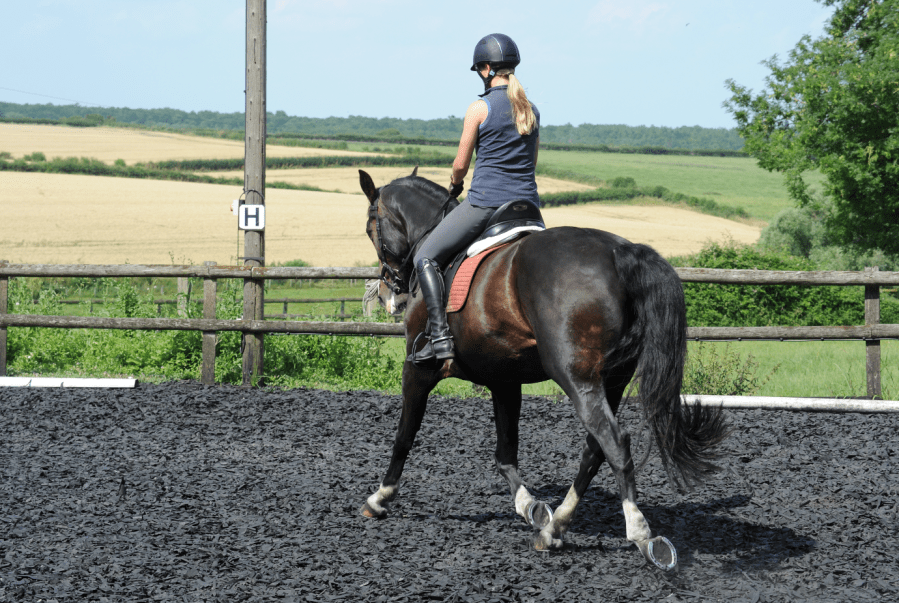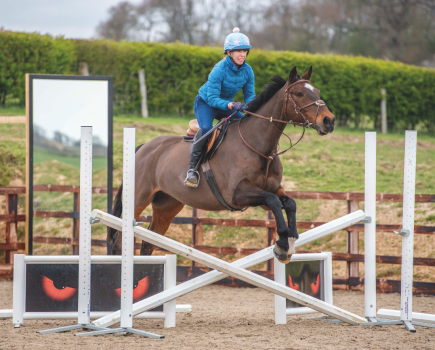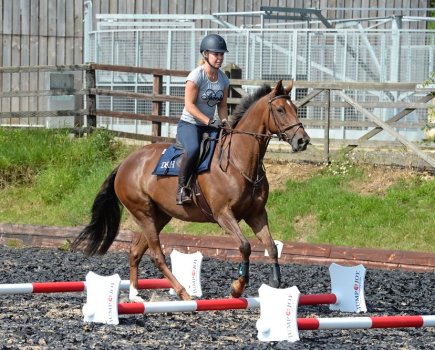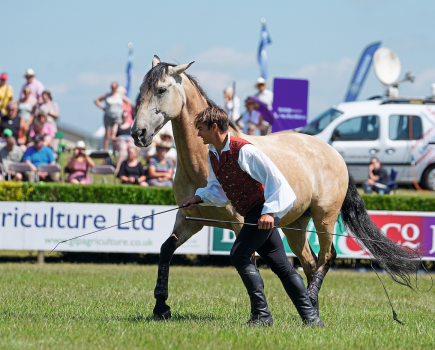How often do you find yourself riding endless circles in your dressage training sessions? There are lots of benefits to riding circles. However, they can encourage your horse to fall onto their inside shoulder, rather than stepping through from the inside hindleg and pushing forwards into a good uphill balance.
To correct this, you need to work on improving the engagement and check your horse is bending through their body, not just their neck. This is much easier to do when you’re riding in a straight line, rather than on a circle. I know I do a lot of circles when I’m schooling — different sizes, in various places around the arena or field, sometimes spiralling in and out. At the end of the day, though, they’re all circles. Do I practise riding in a straight line? Rarely. Do I score a perfect 10 for a straight entry at A? I never have to date. Hmm…
Riding corners
Dressage rider and trainer Dan Greenwood challenges riders to ditch the circles and try his exercises using only straight lines. Straight lines inevitably involve riding around a corner, and these need practising too — there’s plenty to ride in a dressage test, after all.
“When you’re riding a circle or making a turn it’s all too easy to pull your horse around the corner using your inside rein. All this does is place your horse’s head and neck around the corner while their outside shoulder drifts in the opposite direction,” says Dan, who explains that to ride a turn correctly, you need to use your outside aids:
- Move your outside rein so that it’s against your horse’s neck and apply gentle pressure.
- Then use your outside leg to steer your horse around the corner.
- Your inside leg is there to keep the impulsion, while your inside rein guides and creates the bend to the inside — but it doesn’t pull.
“Learn to ride corners from your outside aids and you’ll have much more control over the position of your horse’s shoulders,” adds Dan. “This makes riding circles much easier as you’ll be able to maintain the shape and quality of the circle by riding the outside of your horse’s body rather than just the inside.”
Straight lines: try the square exercise
The first straight lines exercise involves riding a large square. Pick a place in your arena or field to ride the square.
How to ride it
- Begin by riding a square in walk a few times, so that you get a feel for riding an accurate shape. Remember, squares don’t have any curves!
- Next, ride a square in trot. Make a transition to walk just before one of the corners. Ride the turn and then ask for trot again.
- “Do this several times and you’ll begin to find your horse will start to anticipate the walk transition,” says Dan. “Their upward transition to trot will become more balanced too.”
- Mix things up by riding a near-walk transition at every other corner. According to Dan, this is a great way to develop your half-halt.
Things to focus on
- Make sure the lines of your square are straight. Keep your horse’s head and neck straight.
- Just before you turn, position your shoulders to the inside and put a little more weight into the outside of your seat.
- Ride a slight leg yield through the turn and picture pushing your horse’s tummy to the outside.
Straight lines: work towards collection
Dan’s next exercise involves riding half a diamond in canter. “It’s a good way to start teaching your horse to shorten their stride without you using too much rein and holding onto them,” he says.
Ride a half diamond wherever you like. For example, on the right rein, turn off the outside track at E and ride a straight line to G. Then turn right again and ride a straight line to B. Alternatively, you could ride a longer half diamond from C to E and then E to A. Vary where you do it to keep it interesting for your horse.
Things to focus on
Dan recommends focusing on the following while riding this exercise:
- Keep your horse’s neck straight and use your legs to keep their body straight.
- Just before you turn at the point of your diamond, turn your shoulders in the direction of the turn.
- Keep your horse’s neck straight through the turn and use your outside aids. Resist the temptation to pull them round with your inside rein.
- Ride your horse’s inside hindleg through the turn.
“After a few attempts, you’ll feel as if you can let go of the inside rein,” says Dan. “To test your horse is in self-carriage, and that you’re not holding onto your inside rein, try giving and re-taking the inside rein while riding your diamond.”
Straight lines: engage the outside hindleg
“If you stay on a constant circle when schooling, your horse is likely to become heavy on your inside hand,” advises Dan.
To prevent this, Dan suggests riding leg yield in canter away from the outside track. This will encourage your horse to listen to your outside leg. It also improves engagement of their outside hindleg so that they become lighter in your inside rein.
Depending on your horse’s level of training, you may need to do this in trot first and build up to leg yielding in canter as your horse develops.
How to ride it
- Leg yield away from the outside track by about 2m. Then continue down the long side.
- As you ride off the track, have a little more weight on your outside seatbone.
- If you’re riding this exercise on the right rein, the aim is to have the right side of your horse straight and the left side in a slight curve. The horse should be moving to the right.
- As you ride the leg yield, you’re aiming for equal weight from your horse on all four feet and not on their inside shoulder, which can sometimes happen.
Straight lines: improve your connection
“Another exercise to encourage your horse to be reactive to your leg aids while remaining straight in their body is a turn on the forehand,” states Dan.
Ride a large square in walk a little off the outside track. At each corner ride a turn-on-the-forehand. Depending on your horse’s level of training, you don’t need to halt. Simply steady the walk before each corner before riding the movement. Once you’ve mastered this in walk, add a trot transition out of the corner.
How to ride it
- Shorten the stride until your horse almost halts.
- Ask for a little flexion to the inside.
- Have your inside leg at the girth and your outside leg a little behind the girth.
- Use your inside leg to ask your horse to move their inside hindleg to step under their body. They can now pivot around their inside front leg, which steps ever so slightly forward, and move their quarters around their front end.
- Look up where you want to go.
- Keep your hands level as you turn.
- Your inside rein gently leads, balanced by your outside rein to avoid too much bend in the neck.
- Once you complete the movement, ride your horse forward in walk.
- Repeat in the next corner.
Riding straight lines
The more you practise and concentrate on straight lines in a schooling session, the better and more accurate you will get. They will automatically become a regular part of your routine without you really having to think about riding straight lines too.
Remember to do it outside of the arena too, so that you’re not always relying on an arena fence to keep your horse straight. It’s actually a lot trickier than you think when you’re in an open space, because it’s easy to overthink it and therefore over-ride, which causes your horse to wobble and lose balance.
Yep, I’m talking from experience. Now I’m off to practise for that perfect 10…
Dressage trainer and rider Dan Greenwood has won numerous national titles and has competed for Great Britain in small tour and big tour. He is based in the Cotswolds.
Main image: copyright Your Horse Library/Kelsey Media/Matthew Roberts









